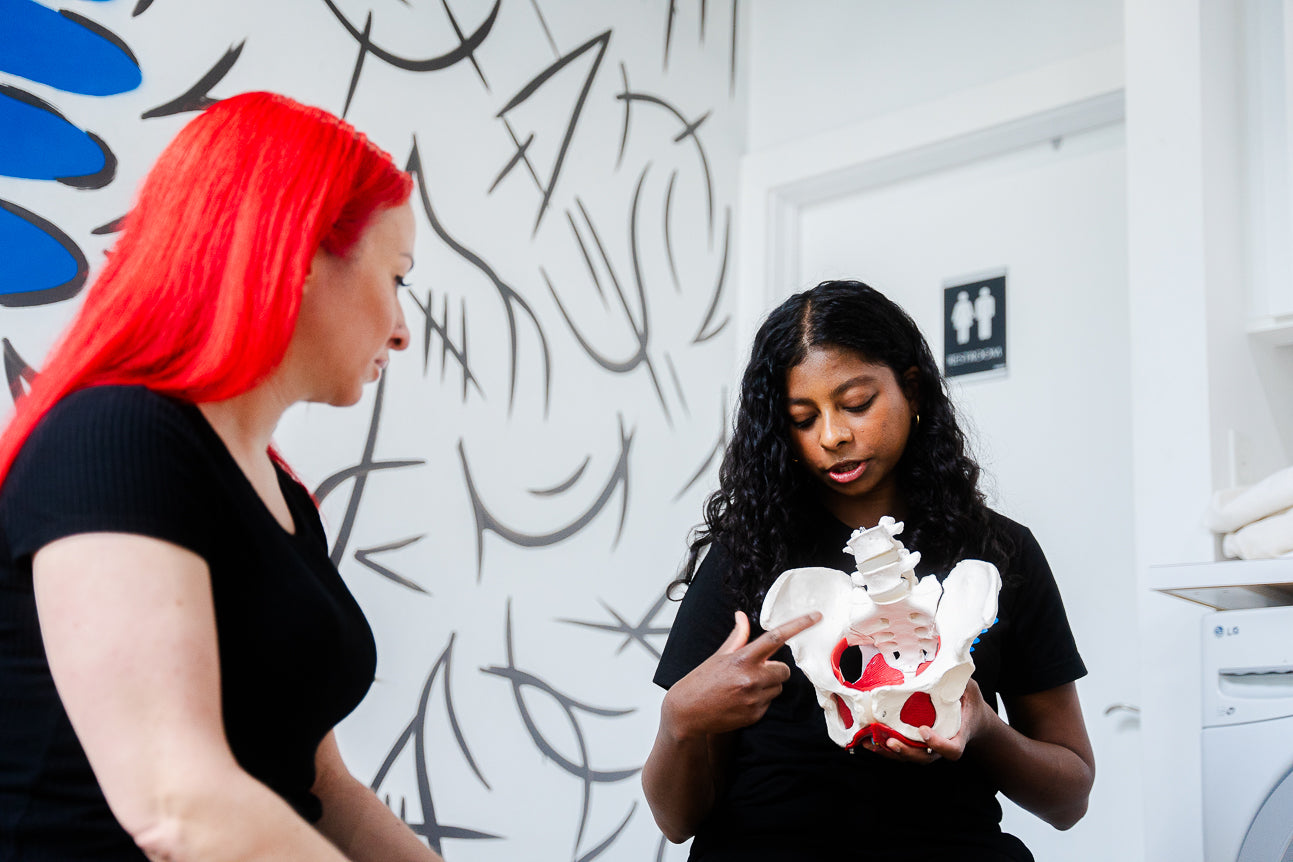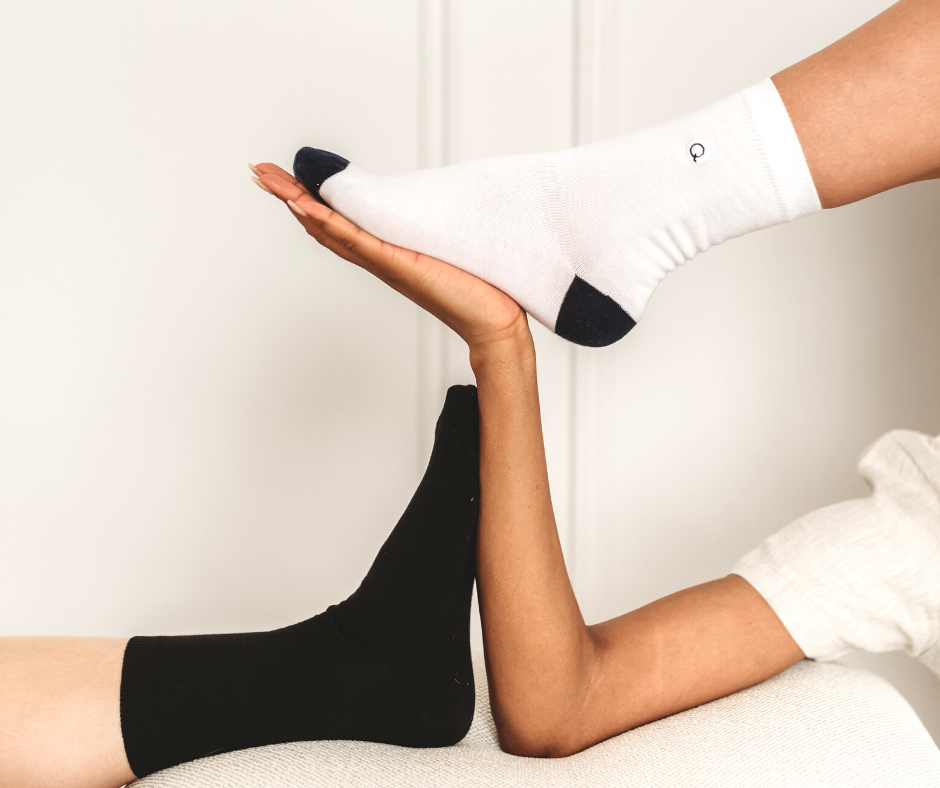Expert insights from Toronto-based pelvic floor physiotherapist Vishnee Visagan on everything you need to know about pelvic health across all life stages.
When we think about overall health and wellness, many of us focus on exercise, nutrition, and mental health—but there's one crucial area that often gets overlooked: pelvic health. Despite playing a vital role in our daily functioning, the pelvic floor remains one of the least understood and most under-discussed aspects of healthcare.
We sat down with Vishnee Visagan, an experienced pelvic floor physiotherapist, to break down everything you need to know about pelvic health, including practical tips for maintaining optimal function throughout your life.
What Exactly Is the Pelvic Floor?

"I would describe it as a group of muscles and connective tissue at the base of the pelvis" explains Vishnee. The pelvic floor is far more complex and important than many people realize.
The pelvic floor has five major functions:
-
Organ Support: It supports your bladder, uterus, and rectum
-
Continence Control: It manages the release and retention of urine and stool
-
Sexual Function: It plays a crucial role in sexual health and pleasure
-
Core Stability: It's an integral part of your core canister system
-
Circulation: It supports circulatory and lymphatic function
"Our pelvic floor is part of this core canister that involves our diaphragm, pelvic floor, the deep abdominals, and our deep low back muscles," Vishnee notes. "How we breathe, how we move—all these things we do in our day-to-day really impact the function and tension in these muscles."
Recognizing the Signs: When Your Pelvic Floor Needs Attention
One of the challenges with pelvic floor dysfunction is that it can present in many different ways. While some signs are more obvious, others might surprise you.
Common Signs of Pelvic Floor Dysfunction:
-
Leakage: Urinary incontinence with coughing, sneezing, exercise, or sexual activity
-
Pain: Low back pain, tailbone pain, or pelvic pain
-
Bathroom urgency: Feeling like you need to run to the bathroom frequently
-
Period pain: Severe menstrual cramping that interferes with daily activities
-
Sexual discomfort: Pain during or after sexual activity
"If you feel like something is going on and doesn't feel absolutely 100% in the pelvic area, the abdominals, or the low back, it might not be a bad idea to get it checked out," advises Vishnee. "These might not be the most comfortable things to talk about, but they could be worthwhile addressing because it could tie back to your pelvic floor muscles."
Common Pelvic Health Myths
Misinformation about pelvic health is unfortunately widespread. Let's address some of the biggest misconceptions:
Myth 1: "Pelvic health is only a women's issue"
Truth: Everyone has a pelvic floor, regardless of sex or gender. "We work with children who have issues going to the bathroom, people who've started to engage in sexual activity, pregnant people, postpartum individuals, people experiencing pelvic issues later in life—we work with everyone," Vishnee explains.
Myth 2: "Leakage is normal as you get older"
Truth: While common, especially postpartum or with aging, leakage is never normal. "Despite what TV ads tell us with all those incontinence products, if you're experiencing leakage, you should talk to your primary health care provider and/or see a pelvic physiotherapist."
Myth 3: "Period pain is just part of being a woman"
Truth: Severe period pain that keeps you from work or requires excessive painkillers isn't normal and should be evaluated by a healthcare provider.
Myth 4: "Kegels fix everything"
Truth: Kegels are often over-prescribed. "If someone has more pelvic muscle tension, we don't want to be contracting the muscle all the time. We want to provide a more holistic exercise program that teaches individuals how to use these muscles effectively," notes Vishnee.
Myth 5: "Only people who had vaginal deliveries need pelvic floor care"
Truth: C-section delivery also requires pelvic floor attention. "Your body goes through so many changes with pregnancy, and a C-section is a major abdominal surgery. You definitely want to get assessed regardless of delivery type."
Pelvic Health Across Life Stages
Childhood and Adolescence
Pelvic health education should start early. Common issues include bathroom difficulties, which can be helped with proper education about bodily functions and breathing techniques.
Reproductive Years
This stage often brings challenges related to periods, sexual activity, and potentially pregnancy. "There's a lack of information about getting your period—you often go off of what your parent tells you or what you learn on the internet," observes Vishnee.
Pregnancy and Postpartum
Pregnancy brings rapid bodily changes, and postpartum recovery involves much more than the standard clearance at six weeks postpartum. Key concerns include:
-
Learning proper lifting techniques for growing babies
-
Scar tissue management (whether from perineal tears or C-section)
-
Safe return to exercise and sports
-
Managing new symptoms that may arise
Menopause and Beyond
Hormonal changes can significantly impact pelvic floor function, and it's never too late to address concerns or optimize function. Speak to your primary care prover about optimizing your overall health during menopause.
Cultural Considerations in Pelvic Health
Cultural background can significantly impact how comfortable people feel discussing pelvic health. Vishnee, who comes from a South Asian background, notes: "In our culture, we generally don't speak a lot about sexual activity or the changes that happen as we age. A lot of things might be dismissed or normalized."
This can lead to people suffering unnecessarily with treatable conditions. "I have clients tell me they never knew sex wasn't supposed to be painful, or that there was help available for period pain beyond painkillers."
Easy Ways to Improve Pelvic Health
Daily Habits That Support Pelvic Health:
-
Practice Deep Breathing: "Some kind of breath work is important at any stage of life. Breathing into the lower abdomen helps lengthen our pelvic floor muscles, which relaxes them and calms our nervous system."
-
Stay Mobile: "We live in a society where we sit too long. Getting up every hour and incorporating enjoyable movement—whether that's walking, yoga, or stretching—is crucial."
-
Maintain Proper Hydration: Drink enough water, based on the weather and your activity levels. You want to aim for light-colored urine when going to the bathroom.
-
Prioritize Digestive Health: "Make sure you’re getting enough fiber and water so your bowel movements pass easily without pushing or straining."
Finding the Right Support

If you're interested in seeing a pelvic floor physiotherapist, know that you typically don't need a referral (though some insurance plans may require one). You can find practitioners through:
-
Online searches and social media
-
Referrals from family doctors, OB-GYNs, urologists, or midwives
-
Word of mouth recommendations
What to Expect in Your First Session
A typical first appointment involves:
-
20-30 minutes of discussion about your health history and concerns
-
Education about pelvic floor anatomy and function
-
Explanation of potential assessment options
-
External physical assessment (breathing, movement, abdominal examination)
-
Discussion of internal assessment options (always optional and based on comfort level)
"You have full control," emphasizes Vishnee. "If you ever feel uncomfortable at any point, you tell me to stop. It's very much an open dialogue, and we have plenty of time."
Recommended Resources for Further Learning
For Children:
-
Books about belly breathing and emotional regulation
-
"Softy the Poop" and similar children's books about bathroom health
For Adults:
-
Dr. Jen Gunter's books: "Blood" (about periods), "The Vagina Bible," and "The Menopause Manifesto"
-
"Power to the Pelvis" by Dr. Alicia Jeffrey (pelvic floor physiotherapist)
-
@ThePelvicDanceFloor, @Boxwellnessco, @The.Vagina.Whisperer (Instagram accounts with educational content)
When seeking information online, always verify that content comes from qualified healthcare professionals rather than unverified social media sources.
Real Life Results

One of the most powerful aspects of addressing pelvic health is how it can transform overall quality of life. Vishnee shares the story of a client who came in skeptical after years of pain and incontinence:
"Over the course of working together for about a year and a half, we saw not just the physical symptoms resolve, but their whole outlook changed. They started prioritizing self-care, had more energy, and felt like their life had dramatically changed—all without needing surgery."
This holistic improvement often extends beyond the physical symptoms to encompass better sleep, and increased confidence.
You Are The Expert of Your Body
Perhaps the most important takeaway from our conversation with Vishnee is this: "You are the expert in your body. You know your body best."
If something feels off, if you're experiencing symptoms that concern you, or if you simply want to optimize your pelvic health, don't dismiss those instincts. Whether it's talking to your family doctor, seeking out a pelvic floor physiotherapist, or simply starting with some of the proactive habits mentioned above, taking that first step toward better pelvic health is always worthwhile.
About The Expert
Vishnee Visagan is a pelvic floor physiotherapist practicing in Toronto. She completed her Master of Physical Therapy at Western University and holds specialized certifications in Pelvic Health Physiotherapy (Levels 1-3 PHS). Passionate about increasing accessibility to pelvic health services and normalizing these important conversations, Vishnee takes a holistic, client-centered approach to help people achieve their functional goals.
Interested in learning more about pelvic health or connecting with Vishnee? Follow her on Instagram for more tips or book an appointment with her.























Leave a comment